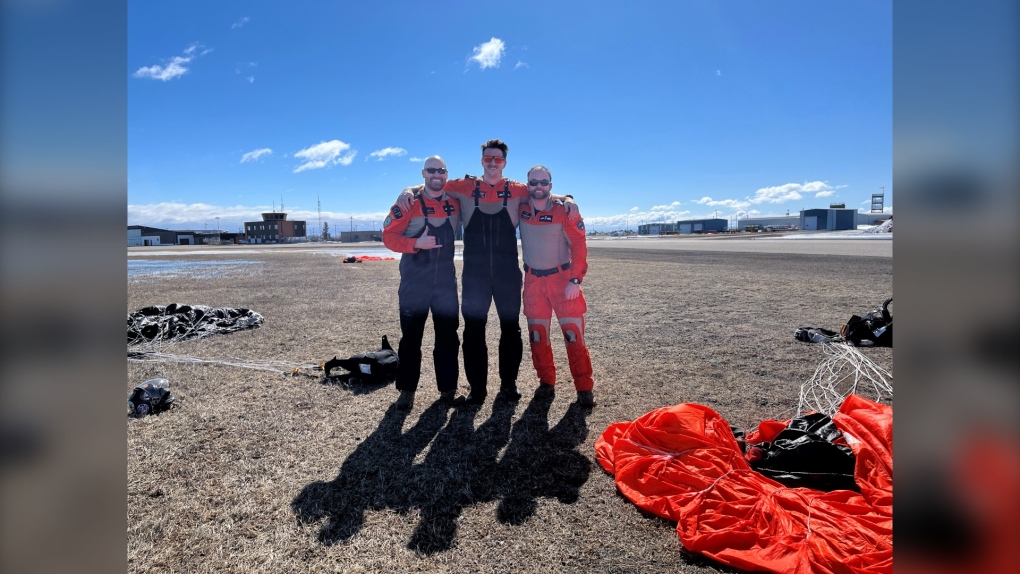Royal Canadian Air Force celebrates centennial with search and rescue training

For members of the Royal Canadian Air Force search and rescue team, jumping off an airplane is just another day at work.
“It felt great, it was good to be back,” said Sgt. Geoff Tallis, SAR Tech Team Lead of the 435 Transport and Rescue Squadron.
“That’s my office so I’m happy to be home doing the job that I love to do.”
Tallis has been a search and rescue technician or SAR Tech with the Royal Canadian Air Force since 2019.
He and his fellow members of the 435 Transport and Rescue Squadron respond to rescue calls. They parachute in when evacuations, plane crashes and other life-threatening situations across the country demand their service.
“There’s a lot going through our minds because, one, we have to be sure that we are being safe for ourselves,” Tallis said.
“But also there’s a lot of mission planning all the way up until the moment our foot leaves that ramp. So one, we want to make sure that we’re able to get down to the casualties on the ground. We also need to ensure that our team members or my own lives are safe when we’re doing our missions.”
The 435 Transport and Rescue Squadron operates out of 17 Wing Winnipeg. Their large rescue coverage area stretches east to the Quebec border, as far north as Iqaluit, Nunavut and westward to British Columbia.
The team makes use of a Lockheed C-130 Hercules Aircraft for rescue missions. As a part of the RCAF’s 100th Anniversary, media were invited to attend a morning and afternoon flyover of Winnipeg and witness search and rescue training jumps parachuting down to the Brandon airport based on better weather conditions in the Westman area. These training exercises are often done weekly throughout southern Manitoba.
SAR Technicians like Tallis undergo extensive training to survive and work in the worst of environmental conditions. While jumping out of a plane routinely may seem reckless, the process uses the utmost precision.
Flight patterns are determined by tossing streamers out first to calculate wind speed and resistance. The pilots and navigators on board work with the search and rescue team to best determine the course of parachuting into a remote area where help is needed.
“It’s all about teamwork and cooperation and obviously lots of trust because as soon as they leave on the airplane, they’re on the ground by themselves,” said Captain Yuri Kostyuchenko, Pilot of the 435 Transport and Rescue Squadron.
“They rely on us to provide proper illumination at night, or their equipment or the gear that’s required for saving the people on the ground.”
Kostyuchenko knew he wanted to be a pilot since he was a kid. After moving from Kyrgyzstan, Kostyuchenko joined the military over a decade ago and has called Winnipeg home since. He worked his way through the ranks of Air Combat Systems Officer to becoming a pilot over that time.
A team brief led by Kostyuchenko before every flight assesses where the emergency is and how the terrain and weather may play factors in their mission. For training purposes, the same rules apply.
“The goal here is to find some realistic training scenarios, something that we have seen in the past or something that’s probably going to happen in the future,” Kostyuchenko said.
“It could either be missing boats, crashed airplanes or even lost hunters, so we develop a scenario and then we go and practise doing it.”
While a lot of time has gone by since he started, he still lives for the thrill of piloting an impressive aircraft like the Lockheed C-130 Hercules.
“It’s still a little, I would say, adrenaline rush,” Kostyuchenko said.
“You’re flying an airplane that’s still all mechanical. It’s all pulleys and levers. You can feel pulling up, pulling down. It’s just a blast. In terms of military pilot, it’s a challenging role. You’ll get to fly airplanes you don’t get to fly anywhere else.”
Monday, April 1 marked 100 years for the Royal Canadian Air Force since its inception in 1924. Members of the team spoke fondly of being able to be working during the centennial.
“Well, it’s a milestone, right?” Kostyuchenko said as he laughed.
“It’s something that we get to live through in our experience and then reflect on how we did over the last decades, hundreds of years. In my case, it would be how did I contribute to this organization over the last couple of decades? How did that go?”
“The air force has evolved so much over 100 years and it’s had to adapt to you know, the world was very different back in 1924,” said Captain Jim Turnbull, Co-Pilot of the 435 Transport and Rescue Squadron.
“I look forward to continuing to adapt as the future changes.”
For Tallis, taking part in these training jumps was refreshing as he was not able to do so for four months prior as a result of recovering from shoulder surgery. The feeling he gets when doing each jump is one of business, not necessarily thrill-seeking.
“We are definitely not adrenaline junkies,” Tallis said.
“We’re not seeking that rush. Our primary goal is to ensure that we can effect a positive rescue and a good outcome. I’m very proud to be a part of the military in this organization, so being here during a historic moment like the centennial makes me very proud.”
Tallis and the rest of his unit are on call to be ready to respond while training Monday through Friday. He explained there are certain times a year for responding that calls that are busier than others.
“For example, in the summertime when people have pleasure crafts out or in the spring when the ice is thawing and hunters are up in the far north hunting seals and belugas and the ice breaks and they fall through. That really changes the dynamic of how frequently calls come in.”
“On weekends, we remain on a call in posture, able to respond to any calls within 2 hours down to 30 minutes when we’re actively in the air or doing training. In the morning we’ll come in, we’ll check the aircraft out, make sure that all the systems are running and all the equipment on the aircraft are good.”
Tallis recalled a memorable rescue early on in his career.
“My proudest rescue was in 2019, in northern Ontario,” Tallis said.
“In December, we did a nighttime rescue for a group of hunters who had a hunting accident and accidentally shot one of their members. He had a gunshot wound through the chest and we were able to get into the confined area, affect the medical and be extracted by helicopter a while later. It was a positive outcome.”
More events for the RCAF’s centennial are planned for later this year.
View original article here Source









